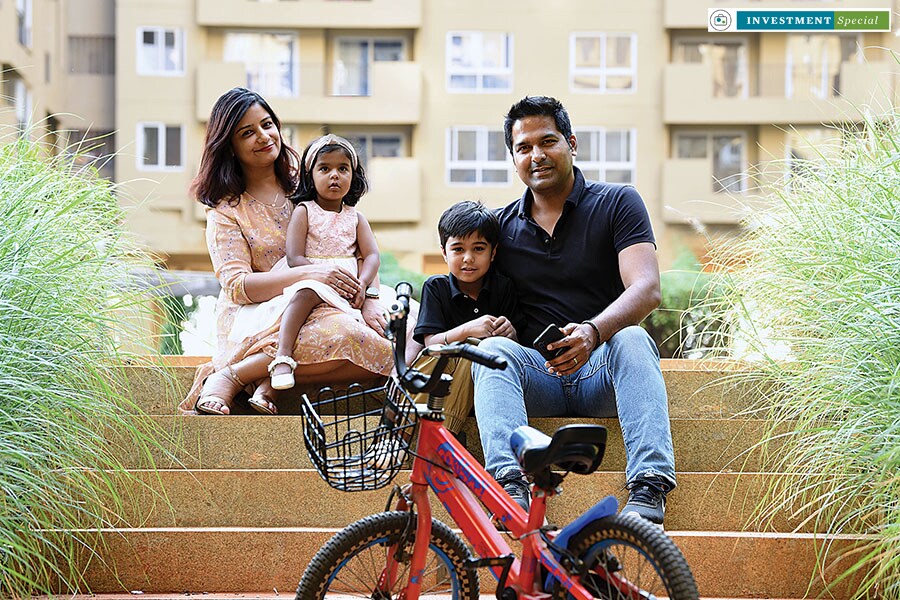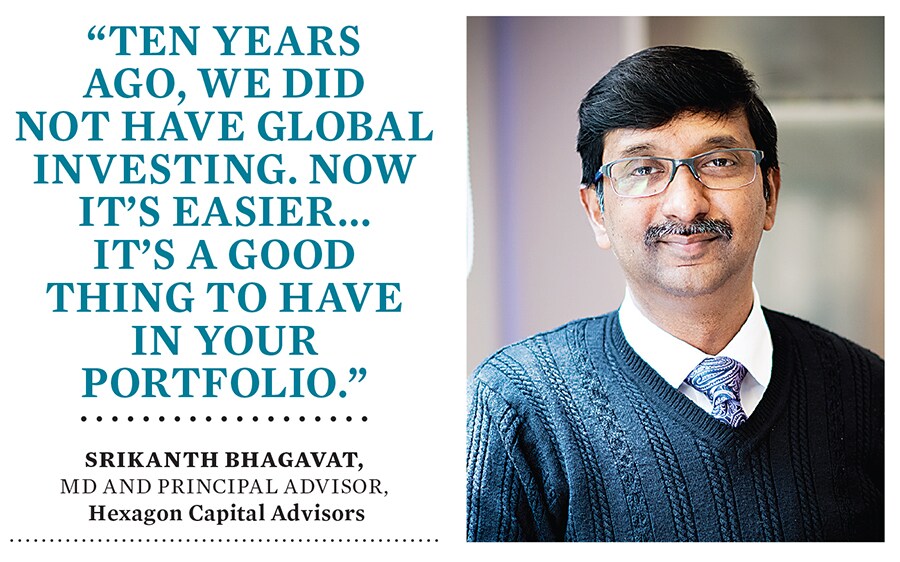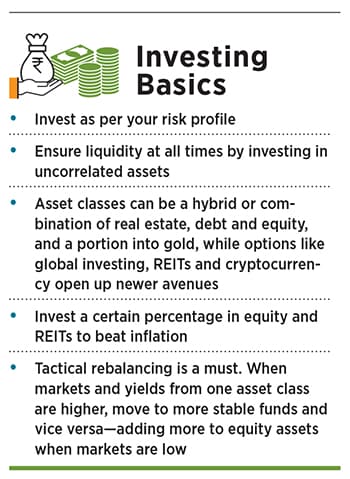Until 10 years ago, when Sumeet Sinha’s father retired, about 90 percent of his savings were in fixed deposits and other fixed income products. It is not that he was not a savvy investor—since the early 90s he had been participating in initial public offerings, and would check annual reports and balance sheets and pick up stocks, but the equity portion was not more than 10 percent.
Ten years later, 40-year-old Sinha’s portfolio also comprises similar elements, but the investment style and ratio is vastly different. “He would not invest 50 percent of his savings in equity, he was doing it in a much smaller ratio, with me that ratio is a lot bigger,” says Sinha, director, global sales operations at Aruba Networks, who started investing when he was about 26, and invests both through Systematic Investment Plans (SIP) and lump sums.
With few investment options to beat inflation and grow wealth, asset allocation for most investors—whether they are working towards goals like children’s education or retirement—is geared towards equity in some form or another with only the ratio changing as per their age and risk profile.
“Generally, people in their 40s are in their accumulation phase and need to be aggressively growing their wealth. And unless they have some constraints, like huge liabilities or family constraints in which case they can’t take a huge risk, they can go anywhere up to 70 percent in equity,” says Srikanth Bhagavat, MD and principal advisor, Hexagon Capital Advisors Pvt. Ltd. The ratio is brought down to 30 percent by the time of retirement, when cash flows are paramount, and “having more will only add to the instability of the portfolio”, he adds. It can be higher than 30 percent only if a person “has a larger than minimum cost... so that you can afford the volatility and it will not impact the cash flow”.![srikant bhagvat srikant bhagvat]() Risk and Returns
Risk and Returns
Asset classes usually encompass real estate, bonds and equity and the investing approach and ratio of these are decided on the basis of the risk profile of the person, in turn a factor of an investor’s willingness and ability. While someone may have the ability to take a high risk, they might not have the willingness for it, and vice versa, points out Harsh Kumar, co-founder and managing partner at Zvest Financial Services.
As an example, if you have a 90-year-old with a heart condition who wants to drive at 200 km an hour, and a 25-year-old who is not willing to learn driving because he or she is afraid of an accident, the 25-year-old has a higher ability and a lower willingness, while vice versa for the 90-year-old. “So on the basis of analysis, return expectations and goals, we design asset allocation models for clients, defining the percentage of fixed income, equity, cryptocurrency, gold etc,” says Kumar.
While real estate rents might provide a stable and steady passive income, the returns, even on, say, a ₹5 crore property, will not be very high. “Besides, you can’t sell one tenth of it and go buy groceries. So it becomes a constraint,” says Bhagavat. An investment into real estate is fine if the corpus size allows it without having to liquidate, but otherwise having liquid instruments is preferred.
Gold, too, can form a percentage of the corpus, but mostly finds favour in a good cycle, like the one we have just gone through. “Practically, we allocate to gold but when its utility is over, we will exit it. It will not be a strategic component of the portfolio, only tactical,” says Bhagavat.
It is important that the asset classes are unrelated or, in other words, the co-relation between the asset classes is low to ensure that not all the classes go down in a bad period and vice versa, because on a bad day if one needs the money, one would have to book losses. It is also important that portfolios are rejigged periodically—when an asset class goes low, you add to it, and when it goes high, book profits and move them to another asset class.![arnab chattopadhayay arnab chattopadhayay]() IBM associate director Arnab Chattopadhayay is set to hike SIP investments to 70-75 percent of his take-home once son Aritro’s education expenses are taken care of in a year or two
IBM associate director Arnab Chattopadhayay is set to hike SIP investments to 70-75 percent of his take-home once son Aritro’s education expenses are taken care of in a year or two
Image: Hemant Mishra for Forbes India[br] Arnab Chattopadhyay, associate director, IBM, who started his investing journey in 2012 when he returned to India from the UK, ensures he reviews his portfolio at least once a month and if things are stable, then every quarter. He initially started saving for his son’s education, and once that was in place, started thinking of a retirement portfolio—a mix of debt, equity as well as a percentage of SIPs into gold bonds. “If the market goes low, we go a bit more on the equity side, if the market is doing well, we come back a bit to the stable side, depending on the correction happening,” says Chattopadhyay, 50, adding that the current market cycle through the pandemic gave him a decent hike in returns—nine percent became 12 percent.
Newer Elements
While the current market cycle may be just another cycle in a 20-year investment journey, there are things that have changed in the past few years, in terms of awareness, investor behaviour and newer avenues.
Global investing for one. “Ten years ago, we did not have global investing, now it’s easier,” says Bhagavat, adding that over the last couple of years they have seen a positive impact in terms of investing, and for its diversification value it makes a good addition even in retirement portfolios. “India is just a drop in the whole global economic ocean. There are many opportunities out there that we don’t have access to and it’s a good thing to have in your portfolio,” he says.
![fixed income fixed income]()
While investing in bitcoins and cryptocurrency remains a grey area, another option advisors are bullish on are REITs, or real estate investment trusts. Global private equity (PE) firm Blackstone Group-backed Embassy Office Parks REIT (Embassy) had launched India’s first REIT in April 2019, and currently there are three REITs available in India. “Over the next four to five years, we would have very good REITs coming in and they should bring a lot of formalisation into real estate for investment purposes,” says Kumar.
According to Bhagavat, in addition to REITs playing a major role, infrastructure investment trusts or InvITs, which manage income-generating infrastructure assets, will also be an important part of investment portfolios. “The government is talking about monetising assets. So highways will be carved into an investment vehicle and all the toll that comes out of the highway is distributed as income. Or in the case of India Grid Trust, it has power distribution rights, so the charges they collect becomes income, and it is a certain, stable income. So it would be exciting to have these.”
The Union Budget this year announced that dividend payments made to REITs and InvITs be exempted from TDS, and enabled debt financing of InvITs and REITs by foreign portfolio investors. Sinha, who has invested some money in REITs, is waiting to see the returns on his investment. “Historically they are able to deliver 9 percent or so. So in my mind I categorise them as a debt option,” he says.
For those with surplus funds or those looking for exoticism in their portfolios, options like angel and PE investments, exposure to sectors like the technology sector in the US, long short products, futures and options, and smallcase products also play a role.
What also differentiates this cycle from previous market cycles is that in the current scenario, inflation seems to be poised to make a return to the financial dictionary this year. While it may just be another cycle and not affect those with a 20-year investing journey, it might change investor outlook making them reset and think more about generating returns higher than inflation.
Chattopadhyay, who invests 60 percent of his take-home income through SIPs, says he would rather be prepared for a higher rate of inflation than lower. He is set to increase investments to even 70 to 75 percent to beat inflation, as his 17-year-old son’s education gets taken care of and he has the leeway to invest more after a year or two.
Though interest rates seem to have stabilised for now, and may remain low, investors are expecting interest rates to firm up over the next couple of years as the economy grows. “It is possible that in the next one or two years we see inflation going up, but interest rates will be kept down. So that could happen temporarily,” says Bhagavat, adding that since the interest rate cycle follows the inflation cycle, if inflation goes up, so will interest rates. But even if interest rates are one percent higher than inflation, post-tax, it remains a lower yield.
In such a scenario, even as one makes changes in strategy and practical adjustments, reducing exposure to fixed deposits in a low-interest world, the base of the retirement portfolio—asset allocation—doesn’t change and equity retains its place. “The only reason equity is there is to combat inflation,” says Bhagavat. “Without that you will suffer. Not having that growth factor in your portfolio will be a luxury. It means you have so much money that you can afford to retain your standard of living through the years even though your wealth is deteriorating in real value.

 Sumeet Sinha, director, global sales operations at Aruba Networks (seen with his family), retains the elements his father used to invest in, but has amped up the equity portion in his portfolio
Sumeet Sinha, director, global sales operations at Aruba Networks (seen with his family), retains the elements his father used to invest in, but has amped up the equity portion in his portfolio Risk and Returns
Risk and Returns IBM associate director Arnab Chattopadhayay is set to hike SIP investments to 70-75 percent of his take-home once son Aritro’s education expenses are taken care of in a year or two
IBM associate director Arnab Chattopadhayay is set to hike SIP investments to 70-75 percent of his take-home once son Aritro’s education expenses are taken care of in a year or two

